2017 MERCEDES-BENZ E43AMG Lights
[x] Cancel search: LightsPage 38 of 482

#Always engage seat belt tongue 2ofthe
seat belt into seat belt buckle 1ofthe cor‐
re sponding seat.
#Press and hold the seat belt outlet release
and slide the seat belt outlet into the desired
position.
#Let go of the belt outlet release and ensure
th at the seat belt outlet loc ksin position. Ve
hicles with PRE-SAFE
®:If th e front seat belt
is not pulled tight across your body, the seat belt
adjustment may automatically apply a cer tain
tigh tening forc e. Do not hold the seat belt tightly
while it is adjusting. You can activate and deacti‐
va te the seat belt adjustment function using the
multimedia sy stem.
* NO
TEDeployment of the Emer gency
Te nsioning Device when the front
passenger seat is unoccupied
If th e seat belt tongue is engaged in the seat
belt buckle of the front passenger seat and
th e front passenger seat is unoccupied, the
Emergency Tensioning Device may depl oyin
th eev ent of an accident.
#Only one person should use each seat
belt at any one time.
Re leasing seat belts
#Press there lease button in the seat belt
buckle and guide the seat belt back with the
seat belt tongue.
Ac tivating or deactivating seat belt adjust‐
ment via the multimedia sy stem
Multimedia sy stem:
,�9�H�K�L�F�O�H.î �9�H�K�L�F�O�H �6�H�W�W�L�Q�J�V.�%�H�O�W
�$�G�M�X�V�W�P�H�Q�W
#Ac tivate Oor deacti vate ª the function.
Seat belt warning for the driver and front
passen ger
The ü seat belt warning lamp in the Instru‐
ment Display is a reminder that all vehicle occu‐
pants must weartheir seat belts cor rectly.
The ü seat belt warning lamp lights up for six
seconds af tereve ryengine start.
In addition, an acoustic warning tone may sound.
When the driver's and front passenger doors are
closed and the driver and front passenger ha ve
fast ened their seat belts, the seat belt warning
goes out.
36 Occupant saf ety
Page 39 of 482
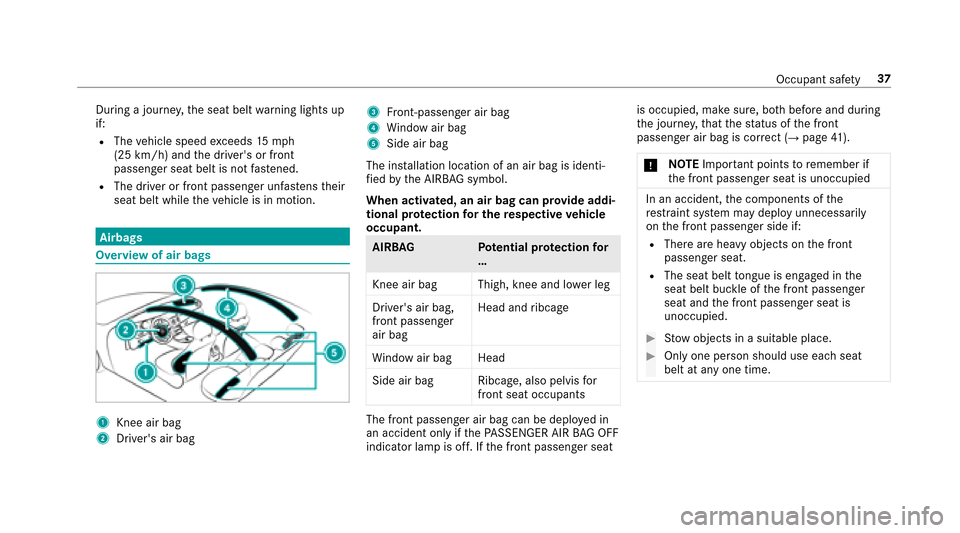
During a journey,th e seat belt warning lights up
if:
RThe vehicle speed exceeds 15mp h
(25 km/h) and the driver's or front
passenger seat belt is not fastened.
RThe driver or front passenger unfas tens their
seat belt while theve hicle is in motion.
Airbags
Overview of air bags
1Knee air bag
2Driver's air bag
3Front-passenger air bag
4Wi ndow air bag
5Side air bag
The ins tallation location of an air bag is identi‐
fi ed bythe AIRB AGsymbol.
When activated, an air bag can pr ovide addi‐
tional pr otection for the respective vehicle
occupant.
AIRB AG Potential pr otection for
…
Knee air bag Thigh, knee and lo wer leg
Driver's air bag,
front passenger
air bag Head and
ribcage
Wi ndow air ba gHead
Side air bag Ribcage, also pelvis for
front seat occupants
The front passenger air bag can be deploy ed in
an accident only if thePA SSENGER AIR BAG OFF
indicator lamp is off. If the front passenger seat is occupied, make sure, bo
thbefore and during
th e journe y,that thest atus of the front
passenger air bag is cor rect (
→page 41).
* NO
TEImpo rtant points toremember if
th e front passenger seat is unoccupied
In an accident, the components of the
re stra int sy stem may deploy unnecessarily
on the front passenger side if:
RThere are heavy objects on the front
passenger seat.
RThe seat belt tongue is engaged in the
seat belt buckle of the front passenger
seat and the front passenger seat is
unoccupied.
#St ow objects in a suitable place.
#Only one person should use each seat
belt at any one time.
Occupant saf ety 37
Page 43 of 482
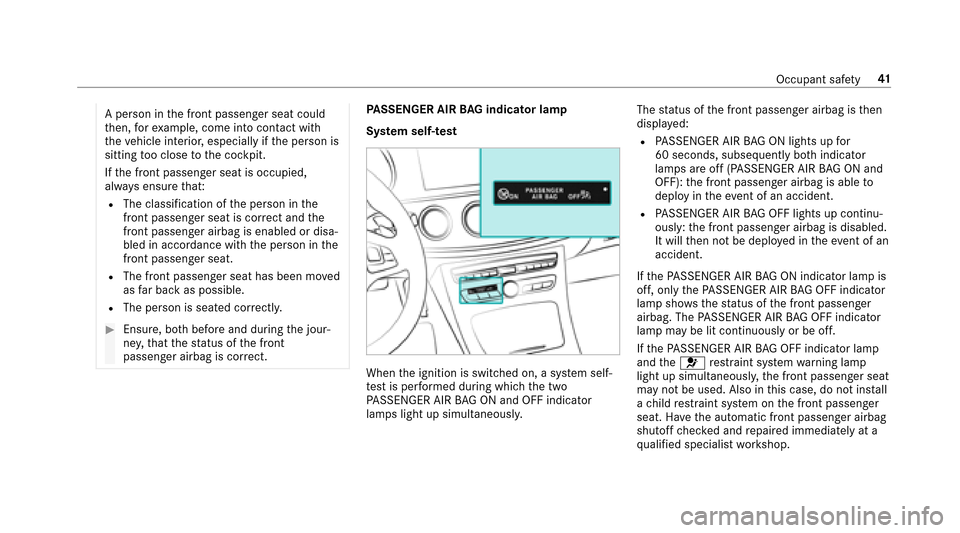
A person in the front passenger seat could
th en, forex ample, come into con tact wi th
th eve hicle interior, especially if the person is
sitting too close tothe cockpit.
If th e front passenger seat is occupied,
alw ays ensure that:
RThe classification of the person in the
front passenger seat is cor rect and the
front passenger airbag is enabled or disa‐
bled in accordance with the person in the
front passenger seat.
RThe front passenger seat has been mo ved
as far back as possible.
RThe person is seated cor rectl y.
#Ensure , bothbefore and during the jour‐
ne y,that thest atus of the front
passenger airbag is cor rect.
PA SSENGER AIR BAG indicator lamp
Sy stem self-te st
Whenthe ignition is switched on, a sy stem self-
te st is per form ed during which the two
PA SSENGER AIR BAG ON and OFF indicator
lamps light up simultaneousl y.The
status of the front passenger airbag is then
displa yed:
RPA SSENGER AIR BAG ON lights up for
60 seconds, subsequently bo thindicator
lamps are off (PASSENGER AIR BAG ON and
OFF): the front passenger airbag is able to
deploy in theeve nt of an accident.
RPASSENGER AIR BAG OFF lights up continu‐
ously: the front passenger airbag is disabled.
It will then not be deplo yed in theev ent of an
accident.
If th ePA SSENGER AIR BAG ON indicator lamp is
off, only thePA SSENGER AIR BAG OFF indicator
lamp sho wsthest atus of the front passenger
airbag. The PASSENGER AIR BAG OFF indicator
lamp may be lit continuously or be off.
If th ePA SSENGER AIR BAG OFF indicator lamp
and the6 restra int sy stem warning lamp
light up simultaneousl y,the front passenger seat
may not be used. Also in this case, do not ins tall
a ch ild restra int sy stem on the front passenger
seat. Ha vethe automatic front passenger airbag
shutoff checked and repaired immediately at a
qu alified specialist workshop.
Occupant saf ety 41
Page 45 of 482
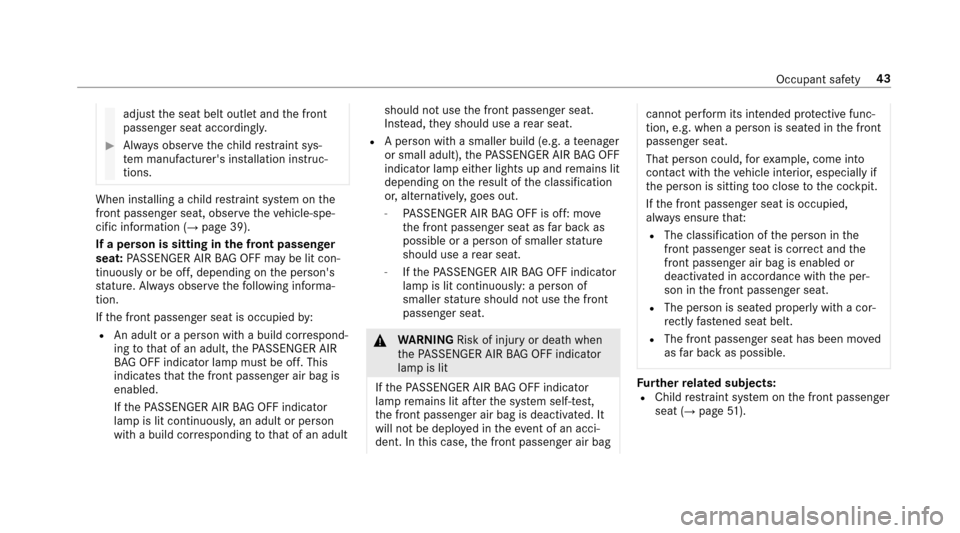
adjustthe seat belt outlet and the front
passenger seat accordingly.
#Alw ays obser vethech ild restra int sys‐
te m manufacturer's ins tallation instruc‐
tions.
When ins talling a child restra int sy stem on the
front passenger seat, observ eth eve hicle-spe‐
cific information (
→page 39).
If a person is sitting in the front passenger
seat: PASSENGER AIR BAG OFF may be lit con‐
tinuously or be off, depending on the person's
st ature. Alw ays obser vethefo llowing informa‐
tion.
If th e front passenger seat is occupied by:
RAn adult or a pe rson with a build cor respond‐
ing tothat of an adult, thePA SSENGER AIR
BA G OFF indicator lamp must be off. This
indicates that the front passenger air bag is
enabled.
If th ePA SSENGER AIR BAG OFF indicator
lamp is lit continuousl y,an adult or person
with a build cor responding tothat of an adult should not use
the front passenger seat.
Ins tead, they should use a rear seat.
RA person with a smaller build (e.g. a teenager
or small adult), thePA SSENGER AIR BAG OFF
indicator lamp either lights up and remains lit
depending on there sult of the classification
or, alternativel y,goes out.
-PA SSENGER AIR BAG OFF is off: mo ve
th e front passenger seat as far back as
possible or a person of smaller stature
should use a rear seat.
-Ifth ePA SSENGER AIR BAG OFF indicator
lamp is lit continuously: a person of
smaller stature should not use the front
passenger seat.
& WARNING Risk of injury or death when
th ePA SSENGER AIR BAG OFF indicator
lamp is lit
If th ePA SSENGER AIR BAG OFF indicator
lamp remains lit af terth e sy stem self-test,
th e front passenger air bag is deactivated. It
will not be deplo yed in theeve nt of an acci‐
dent. In this case, the front passenger air bag
cannot perform its intended pr otective func‐
tion, e.g. when a person is seated in the front
passenger seat.
That person could, forex ample, come into
con tact wi th theve hicle interior, especially if
th e person is sitting too close tothe cockpit.
If th e front passenger seat is occupied,
alw ays ensure that:
RThe classification of the person in the
front passenger seat is cor rect and the
front passenger air bag is enabled or
deactivated in accordance with the per‐
son in the front passenger seat.
RThe person is seated properly with a cor‐
re ctly fastened seat belt.
RThe front passenger seat has been mo ved
as far back as possible.
Fu rther related subjects:RChild restra int sy stem on the front passenger
seat (→page 51).
Occupant saf ety 43
Page 59 of 482
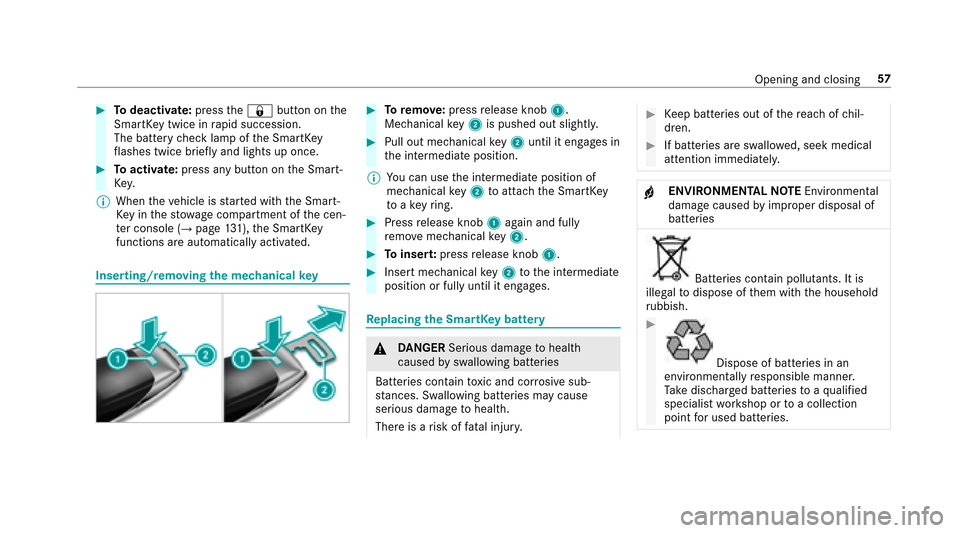
#Todeactivate: pressthe& button on the
SmartK eytwice in rapid succession.
The battery check lamp of the SmartK ey
fl ashes twice brief lyand lights up once.
#To activate: press any button on the Smart‐
Ke y.
% When theve hicle is star ted with the Smart‐
Ke yin thestow age compartment of the cen‐
te r console (
→page 131), the SmartK ey
functions are au tomatically activated.
Inserting/re moving the mechanical key
#To remo ve:press release knob 1.
Mechanical key2 is pushed out slight ly.
#Pull ou tme chanical key2 until it en gage s in
th e intermediate position.
% You can use the intermediate position of
mechanical key2 toattach the SmartK ey
to ake yring.
#Press release knob 1again and fully
re mo vemechanical key2.
#To inser t:press release knob 1.
#Insert mechanical key2 tothe intermediate
position or fully until it engages.
Re placing the SmartK eybattery
&
DANG ER Serious damage tohealth
caused byswallowing batteries
Batteries contain toxic and cor rosive sub‐
st ances. Swallowing batte ries may cause
serious damage tohealth.
There is a risk of fata l injur y.
#Keep batteries out of there ach of chil‐
dren.
#If batteries are swallo wed, seek medical
attention immediately.
+ENVIRONMEN TALNO TEEnvironmental
damage causedbyimproper disposal of
batteries
Bat teries conta in pollutants. It is
illegal todispose of them with the household
ru bbish.
#
Dispose of batteries in an
environmen tally responsible manner.
Ta ke dischar ged batteries toaqu alified
specialist workshop or toa collection
point for used batteries.
Opening and closing 57
Page 88 of 482

#Press button1repeatedly until the indica‐
to r lamp in the button lights up.
The front passenger seat is selected.
#Ad just the front passenger seat using the
buttons in the door control panel on the driv‐
er's side.
Ad justing the 4-w aylumbar support
1Toraise
2To sof ten
3To lowe r
4To harden
#Using buttons 1to4, adjust the conto ur
of the backrest individually tosuit your bac k.
Headrestra ints
Ad justing the front seat head restra ints man‐
ually
& WARNING Risk of injury from adjusting
th eve hicle settings while theve hicle is in
motion
Yo u could lose cont rol of theve hicle in the
fo llowing situations:
Rifyo u adjust the driver's seat, the head
re stra int, thesteering wheel or the mir ror
while theve hicle is in motion
Rifyo ufa sten your seat belt while theve hi‐
cle is in motion
#Before starting the engine: adjust the
driver's seat, the head restra int, the
st eering wheel or the mir ror and fasten
yo ur seat belt.
86
Seats and stowing
Page 110 of 482
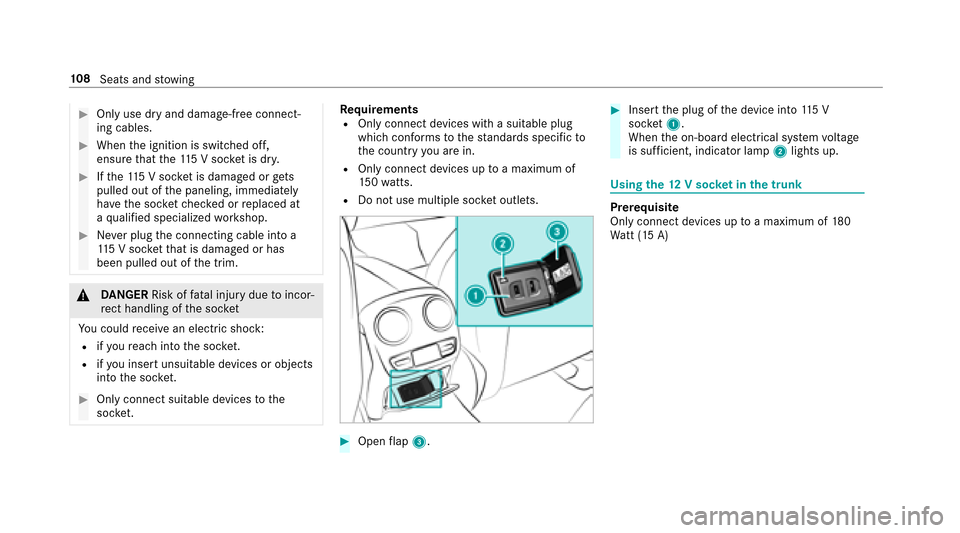
#Only use dry and damage-free connect‐
ing cables.
#Whenthe ignition is switched off,
ensure that the11 5 V soc ket is dr y.
#Ifth e11 5 V soc ket is damage d orgets
pulled out of the paneling, immediately
ha ve the soc ketch ecked or replaced at
a qu alified specialized workshop.
#Ne ver plug the connecting cable into a
11 5 V soc ketth at is damaged or has
been pulled out of the trim.
&
DANG ER Risk of fata l injury due toincor‐
re ct handling of the soc ket
Yo u could receive an electric shock:
Rifyo ure ach into the soc ket.
Rifyo u insert unsuit able devices or objects
into the soc ket.
#Only connect suitable devices tothe
soc ket.
Re quirementsROnly connect devices with a suitable plug
which con form sto thest andards specific to
th e count ryyou are in.
ROnly connect device s uptoa maximum of
15 0wa tts.
RDo not use multiple soc ket outlets.
#Open flap 3.
#Insert the plug of the device into 115 V
soc ket1.
When the on-board electrical sy stem voltage
is suf ficient, indicator la mp2lights up.
Using the12 V sock etinthe trunk
Prerequisite
Only connect devices up toa maximum of 180
Wa tt (15 A)
108
Seats and stowing
Page 114 of 482
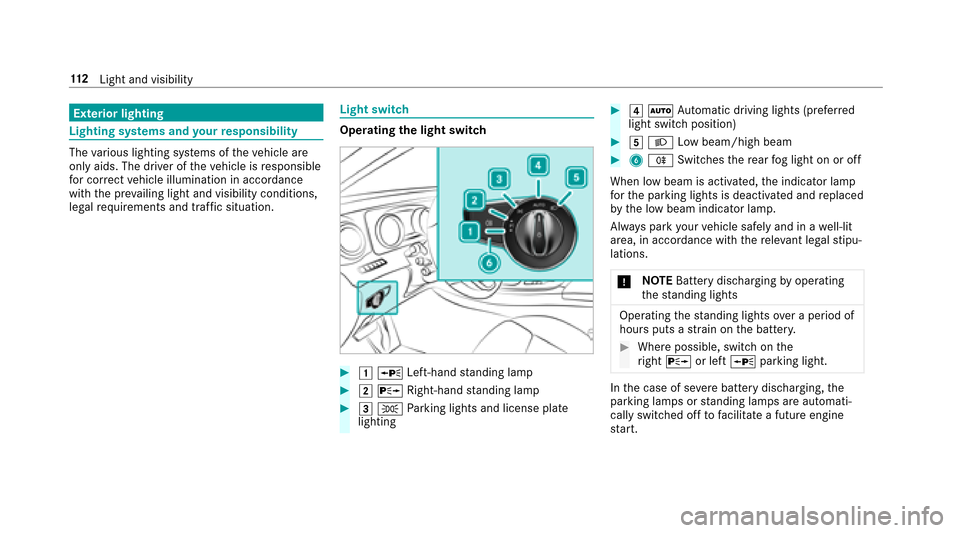
Exterior lighting
Lighting systems and your responsibility
The various lighting sy stems of theve hicle are
only aids. The driver of theve hicle is responsible
fo r cor rect vehicle illumination in accordance
with the pr evailing light and visibility conditions,
legal requirements and traf fic situation.
Light switch
Opera ting the light switch
#1W Left-hand standing lamp
#2 X Right-hand standing lamp
#3 T Parking lights and license plate
lighting
#4 Ã Automatic driving lights (prefer red
light switch position)
#5 L Low beam/high beam
#6R Switches there ar fog light on or off
When low beam is activated, the indicator lamp
fo rth e parking lights is deactivated and replaced
by the low beam indicator lamp.
Alw ays park your vehicle safely and in a well-lit
area, in accordance with there leva nt le galst ipu‐
lations.
* NO
TEBattery discharging byoperating
th est anding lights
Operating thest anding lights over a period of
hours puts a stra in on the batter y.
#Where possible, switch on the
ri ght X or left Wparking light.
Inthe case of se vere battery discharging, the
parking lamps or standing lamps are automati‐
cally switch ed offtofacilitate a futu reengine
st art.
11 2
Light and visibility